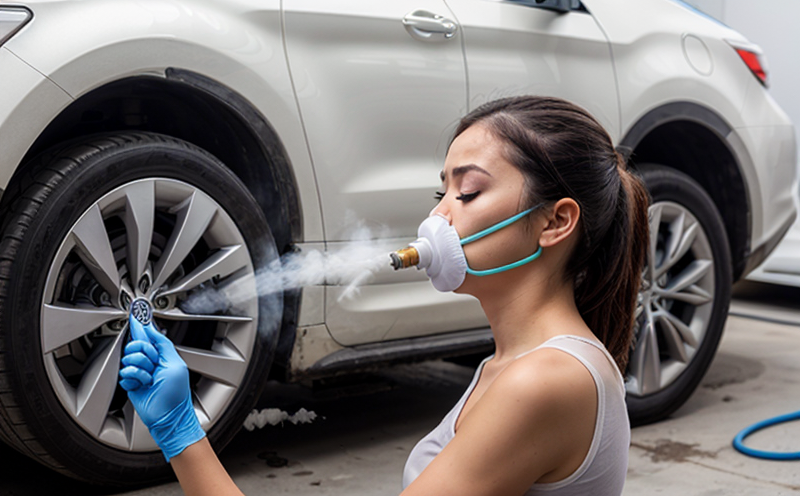ISO 12219 Emission Testing of Volatile Compounds in Vehicle Interiors
The ISO 12219 standard, titled Determination of volatile compounds from vehicle interiors by thermal desorption/gas chromatography-mass spectrometry (TD/GC-MS), is a pivotal method for quantifying the volatile organic compounds (VOCs) emitted from materials used in automotive interiors. This testing is essential for ensuring that the interior environment of vehicles complies with stringent air quality regulations, thereby protecting occupants' health and well-being.
Understanding the source and concentration levels of these VOCs allows manufacturers to identify potential risks associated with off-gassing during vehicle use. The standard aims to provide a standardized procedure for sampling, preparation, analysis, and reporting. Compliance with ISO 12219 ensures that vehicles meet international emission standards, particularly those set by organizations like the European Union's New European Drive Cycle (NEDC) and Worldwide harmonized Light vehicles Test Procedure (WLTP).
The testing process involves several critical steps: sampling, desorption, preparation of samples for analysis, and finally, using a combination of thermal desorption and gas chromatography-mass spectrometry to identify and quantify the VOCs present. This method ensures high precision in measuring emissions over time.
During specimen preparation, particular attention is given to the selection of appropriate materials that can simulate real-world conditions accurately. The sample preparation process must be conducted under controlled conditions to avoid contamination or degradation of the compounds being analyzed.
The ISO 12219 standard specifies detailed sampling protocols and the use of thermal desorption systems coupled with gas chromatography-mass spectrometry for analysis. This approach allows for the detection of even trace amounts of VOCs, providing a comprehensive picture of emissions from vehicle interiors.
Once the samples are analyzed, the results must be reported according to the guidelines provided in ISO 12219. The report should include all detected compounds along with their respective concentrations and any relevant metadata such as sampling time and location.
The significance of ISO 12219 testing extends beyond mere compliance; it also contributes to enhancing product quality by identifying potential issues early in the development process. By ensuring that vehicles meet stringent emission standards, manufacturers can reduce the risk of health hazards for end-users and improve overall customer satisfaction.
- Industry Applications: Automotive manufacturing, environmental protection agencies
- Why Choose This Test: Ensures compliance with international standards, improves product quality, enhances occupant safety
In conclusion, ISO 12219 emission testing is a vital tool for the automotive industry. By adhering to this standard, manufacturers can ensure that their vehicles meet strict emissions requirements while also contributing to safer and healthier interiors.
Industry Applications
- Automotive Manufacturing: Ensuring compliance with international emission standards for vehicle interiors
- Environmental Protection Agencies: Monitoring the impact of VOCs on air quality and public health
- R&D Engineers: Identifying potential issues in materials used in automotive interiors
- Procurement Departments: Assessing suppliers' adherence to environmental regulations
The ISO 12219 standard is particularly beneficial for R&D engineers who need accurate data on emissions from new materials. By using this test, they can identify which compounds are most likely to be problematic and take necessary actions during the development phase. This proactive approach helps in minimizing post-production issues and ensuring that vehicles meet regulatory requirements.
For procurement departments, ISO 12219 testing provides a means to evaluate suppliers' adherence to environmental regulations. By selecting vendors who comply with this standard, companies can ensure that their supply chain maintains high standards of quality and safety.
Environmental protection agencies also benefit from ISO 12219 testing as it aids in monitoring the impact of VOCs on air quality and public health. By regularly performing these tests, authorities can track trends over time and implement targeted interventions to mitigate potential risks.
Eurolab Advantages
At Eurolab, we are committed to providing the highest quality of testing services. Our ISO 12219 emission testing is conducted using state-of-the-art equipment and experienced technicians who understand the nuances of this complex process.
- Expertise: Our team has extensive experience in performing ISO 12219 tests, ensuring accurate and reliable results.
- Accurate Results: We use precision instruments to measure VOC emissions accurately.
- Comprehensive Reporting: Eurolab provides detailed reports that include all detected compounds along with their respective concentrations.
- Quick Turnaround: Our efficient processes allow for rapid turnaround times without compromising on quality.
We pride ourselves on delivering comprehensive testing solutions tailored to the specific needs of our clients. Whether you are a manufacturer looking to ensure compliance or an R&D engineer seeking insights into material selection, Eurolab is your trusted partner in achieving excellence through rigorous testing and analysis.
Why Choose This Test
- Compliance with International Standards: Ensures that your products meet the highest regulatory requirements.
- Improves Product Quality: Identifies potential issues early in the development process, leading to better product performance and reliability.
- Enhances Occupant Safety: By minimizing emissions from vehicle interiors, you contribute to a safer and healthier environment for occupants.
- Sustains Competitive Advantage: Demonstrating compliance with international standards can set your brand apart in the market.
The ISO 12219 emission testing is a critical step in ensuring that vehicles meet stringent emissions requirements. This testing not only helps manufacturers comply with regulations but also enhances product quality and occupant safety, ultimately contributing to sustained competitive advantage in the industry.





